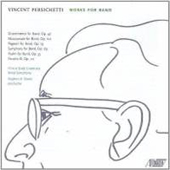
ESSENTIAL RECORDINGS

1- Divertimento for Band, Op. 42
2- Masquerade for Band, Op. 102
3- Pageant for Band, Op. 59
4- Symphony for Band (Symphony No. 6), Op. 69
5- Psalm for Band, Op. 53
6- Parable IX, Op. 121
Some pieces of music are so well written that regardless of the instrument(s) they are assigned to, they always sound good. In some cases, the opposite is true, in that
some composers instinctively know exactly which instrument(s) should be used to perform a specific piece of music. In the case of these Works for Band
by American composer Vincent Persichetti (1915-1987), I believe both angles of approach work.
My usual reaction when listening to a work orchestrated solely for wind instruments and percussion ensemble, is to find it lacking in color and warmth because stringed
instruments are missing. But Vincent Persichetti balances the brass and woodwind instruments so well, and adds texture to the sound by integrating various percussion
instruments into the fabric of the work, that you quickly get drawn into the music and don't realize that strings are missing. Not surprising when you consider that this
composer was an organist from his early years on, which forces one to develop a strong sense of proportion through the constant choice of different stop registrations
from piece to piece. Add also the fact that he was a prolific composer for a myriad of solo instruments as well as various groupings, and an astute conductor who studied
under Fritz Reiner, further enhancing his orchestration abilities.
The Divertimento for Band, Op. 42, laid out over six movements, starts out with a rollicking Prologue that immediately demonstrates
Persichetti's sharp rhythmic writing. The Dance movement brings out a perfect balance of humour and form, whereas the heartfelt Soliloquy is a prime example of warmth
and emotive strength without the need for violins and cellos. Although the Masquerade for Band, Op. 102 was composed much later, it is
still written with the same level of keen orchestral balance and voicing, cohesive structure and strong rhythmic pulse. The harmonic language though has become much
more developed, dense and fascinating. The Parable IX, Op. 121, premièred in 1973, exhibits an even deeper and personal harmonic
style and motivic development, that requires pinpoint accuracy, dynamic balance and emotive participation from all players involved. These works could all be considered
symphonic by nature if not by name.
The Illinois State University Wind Symphony members, under the direction of Stephen K. Steele, deliver an incredible performance
of all these works. As mentioned before, they play so well that, even without strings, one could mistake them for a symphony orchestra. Their conductor, who is also a
teacher, administrator, adjudicator, and guest conductor all over North America, has shaped them to become one of the prime wind ensembles in the world.
Jean-Yves Duperron - April 2011